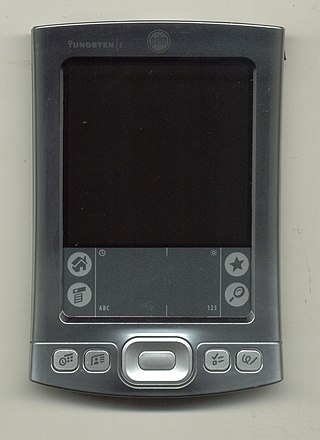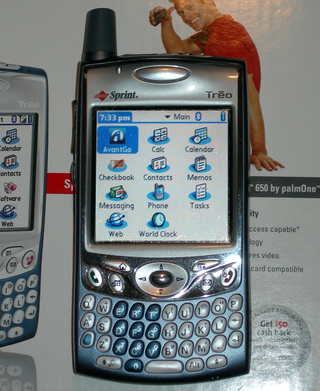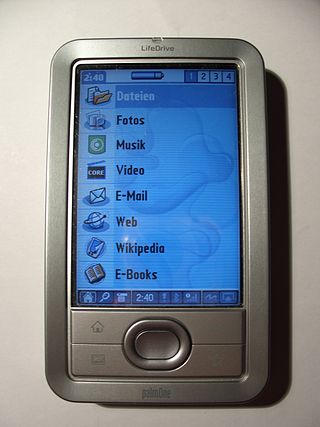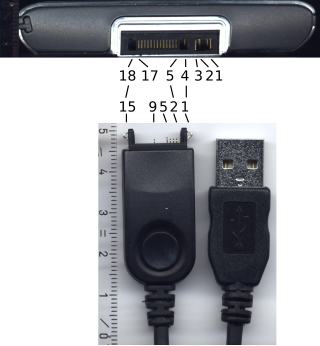
Palm OS is a discontinued mobile operating system initially developed by Palm, Inc., for personal digital assistants (PDAs) in 1996. Palm OS was designed for ease of use with a touchscreen-based graphical user interface. It was provided with a suite of basic applications for personal information management. Later versions of the OS were extended to support smartphones. The software appeared on the company's line of Palm devices while several other licensees have manufactured devices powered by Palm OS.

A Pocket PC is a class of personal digital assistant (PDA) that runs the Windows Mobile operating system, which is based on Windows CE/Windows Embedded Compact, and that has some of the abilities of modern desktop PCs. The name was introduced by Microsoft in 2000 as a rebranding of the Palm-size PC category and was marketed until 2007. Some of these devices also had integrated phone and data capabilities, which were called Pocket PC Phone Edition. Windows "Smartphone" is another Windows CE based platform for non-touch and non-PDA devices.

Palm is a now discontinued line of personal digital assistants (PDAs) and mobile phones developed by California-based Palm, Inc., originally called Palm Computing, Inc. Palm devices are often remembered as "the first wildly popular handheld computers," responsible for ushering in the smartphone era.
XScale is a microarchitecture for central processing units initially designed by Intel implementing the ARM architecture instruction set. XScale comprises several distinct families: IXP, IXC, IOP, PXA and CE, with some later models designed as system-on-a-chip (SoC). Intel sold the PXA family to Marvell Technology Group in June 2006. Marvell then extended the brand to include processors with other microarchitectures, like Arm's Cortex.
The Zire Series was Palm, Inc's "consumer-grade" brand of Personal Digital Assistant.

The Tungsten series was Palm, Inc.'s line of business-class Palm OS-based PDAs.

The Palm Treo 650 is a Palm OS-based smartphone, the successor to Palm's Treo 600. It began shipping in November 2004, and was discontinued in 2008.

The LifeDrive is a Palm OS-based handheld personal digital assistant device that was produced by PalmOne, a former incarnation of Palm, Inc. The device was PalmOne's first and only foray into the "Mobile Manager" device category. As its name suggests, Palm intended the LifeDrive to be capable of providing all the capabilities and data storage space that a user could possibly need during the course of the day, including contacts, calendar, music, images, video, and applications. At the time of release, the 4-gigabyte capacity that was chosen for this task could not be achieved using the flash memory used by most PDAs, while keeping the cost of the device low enough for consumer purchase. For this reason, a 4 GB microdrive hard disk drive was selected for the task. It featured a separate data partition that could be used as a portable disk drive. The LifeDrive featured Bluetooth and Wi-Fi connectivity, the first Palm handheld to feature both. The device came pre-loaded with eReader, Documents To Go, and WiFile software.
The Motorola ROKR, the first version of which was informally known as the iTunes phone, was a series of mobile phones from Motorola, part of a 4LTR line developed before the spin out of Motorola Mobility. ROKR models were released starting in September 2005 and ending in 2011, because of the dissolution of Motorola Inc.. They were notable for incorporating support of media player features.

The Palm Multi-Connector is a power, audio and data interface connector designed by Palm, Inc.

The Z22 was one of the first of Palm, Inc.'s handhelds to be released under the new "Palm" brand, and the first to be released without the "Zire" moniker. Released on October 12, 2005, it replaced the monochrome Zire 21, and was priced at $99 USD. The Palm Z22 came with Palm OS Garnet 5.4.9 preloaded and is not upgradable. It featured a 200 MHz Samsung S3C2410 ARM processor developed around the 32-bit ARM920T core that implements the ARMv4T architecture. The Z22 ran on a li-ion battery that had a life of about 8 hours depending on usage.

Blazer was a web browser available for Palm handhelds running Palm OS 3.1 or higher.

The Palm Treo 700p is a cell phone with advanced capabilities, commonly referred to as a smartphone. Unlike the slightly earlier Treo 700w, this model is based on Palm OS. This is the first Palm OS-based Treo model to feature high-speed cellular network support, and is also the first Treo model to support Bluetooth 1.2.

The Palm Treo 680 is a combination hybrid PDA/cellphone, or smartphone as the successor to the company's Treo 650.

The Treo 755p is a smartphone developed by Palm, Inc. It was released on May 15, 2007 as the first CDMA Treo without an aerial antenna. This Treo has a form factor similar to that of the GSM Treo 680, and is equipped with the full Palm OS. It has been described as a Treo 700p in a Treo 680's body.
Handspring, Inc., was an American electronics company founded in 1998 by the founders of Palm, Inc., after they became dissatisfied with the company's direction under the new owner 3Com. The company developed Palm OS–based Visor- and Treo-branded personal digital assistants. In 2003, the company merged with Palm, Inc.'s hardware division.

The Nokia 6280 Series, is a series of slider type phones first released in Q4, 2005.

The Palm Treo Pro is a combination PDA/cell phone offered in both GSM and CDMA. It is Palm's fourth Windows Mobile Treo. It replaced the short-lived Sprint Treo 800w.













